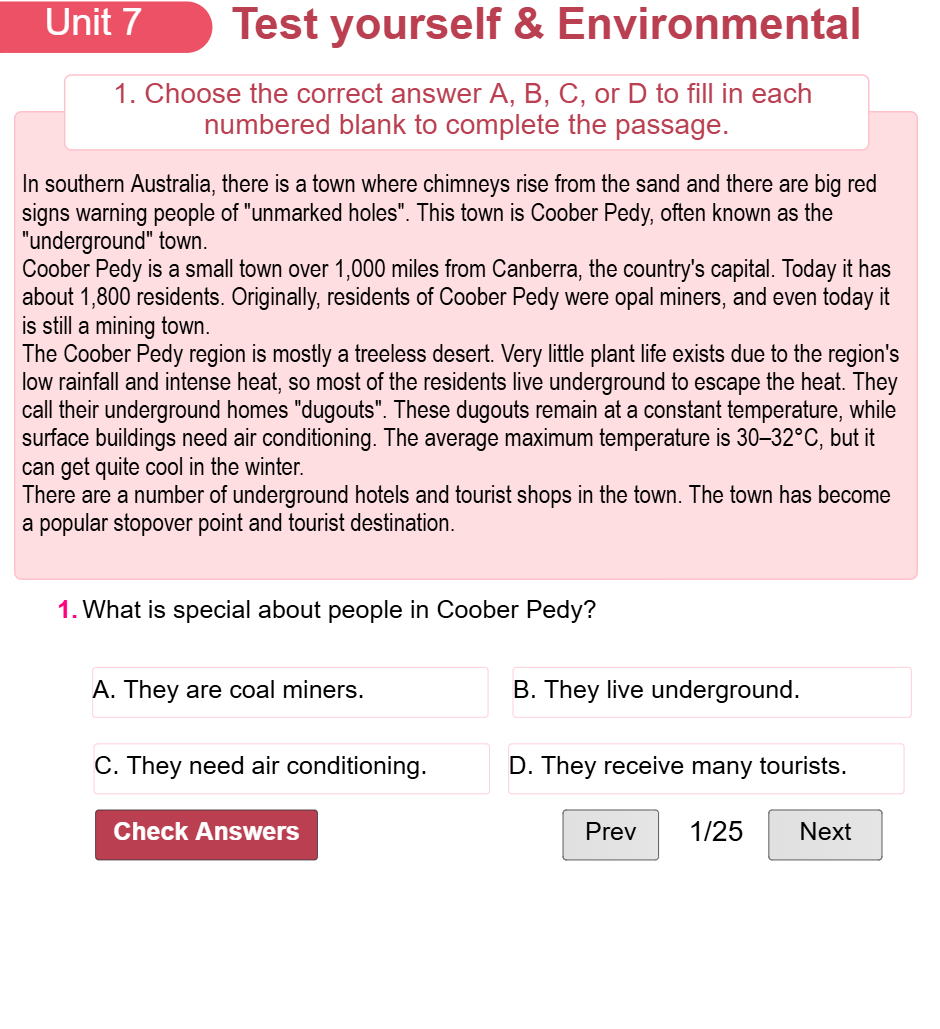📖 Unit 7: Test yourself & Environmental Protection - Reading lớp 8
💎 Unit 7: Test yourself & Environmental Protection
In southern Australia, there is a town where chimneys rise from the sand and there are big red signs warning people of "unmarked holes". This town is Coober Pedy, often known as the "underground" town.
Coober Pedy is a small town over 1,000 miles from Canberra, the country's capital. Today it has about 1,800 residents. Originally, residents of Coober Pedy were opal miners, and even today it is still a mining town.
The Coober Pedy region is mostly a treeless desert. Very little plant life exists due to the region's low rainfall and intense heat, so most of the residents live underground to escape the heat. They call their underground homes "dugouts". These dugouts remain at a constant temperature, while surface buildings need air conditioning. The average maximum temperature is 30–32°C, but it can get quite cool in the winter.
There are a number of underground hotels and tourist shops in the town. The town has become a popular stopover point and tourist destination.
⭐⭐⭐
Each country has its own special traditions and customs just as individuals have their own (1) ______ and daily routines. Many people find it difficult to get used to the customs of another country (2) ______ they go abroad. For example, in some Asian countries, people do not usually finish everything on their plates, because it is a (3) ______ that they have not had enough to eat. Visitors from the West find it difficult to (4) ______ used to this, because they usually eat everything up to show that they liked it. When an Asian host sees their (5) ______ plates, he usually assumes that they want more.
⭐⭐⭐
Like many countries, Britain has serious environmental problems. In 1952, more than 4,000 people died in London because of the smog. The government introduced new laws to stop smog from coal fires and factories and the situation improved a lot.
Today, London is much cleaner but there is a new problem: smog from cars. In December 1991, there was very little wind in London and pollution increased. As a result, about 160 people died from pollution in just four days.
Part of the problem is the new “out of town” shopping centres. In the past, people often walked to shops near their homes or went by bus. Now, many people drive to the new shopping centres. The small shops have disappeared and more people have to travel to do their shopping.
Many people are trying to reduce the use of cars in Britain. Some cities now have special bicycle lanes, so people cycle to work. Some people also travel to work together in one car to reduce pollution and costs.
⭐⭐⭐
A greenhouse is a building made of glass, where you can grow flowers and vegetables that need a lot of warmth. Sunlight (1) ______ through the glass and warms the greenhouse while the glass keeps the heat from escaping.
The Earth is surrounded by a blanket of gases that acts just (2) ______ a greenhouse. Factories, electric power plants and cars make a lot of new gases. These gases are trapping more and more of the sun's (3) ______. This is called “the greenhouse effect”.
If the Earth's temperature increases by just a few degrees, it will change the weather all over the planet. Some places will become too hot to live in or to grow (4) ______ any more. This will cause a lot of people to starve.
That is why people must do their best to stop the greenhouse effect by (5) ______ fewer energy-consuming products and planting trees.
⭐⭐⭐
About 65 million years ago, the dinosaurs became extinct. The hot, dry climate of the Cretaceous Period quickly changed as a result of an asteroid hitting the Earth. This collision sent dust and debris (1) ______ the atmosphere which blocked sunlight from reaching the Earth's surface. The dinosaurs could not quickly adapt to the Earth's colder climate and eventually became (2) ______.
While the dinosaurs are no longer with us, today a number of plant, insect, and animal species are finding their habitats being destroyed, and they too are in danger of extinction. Human activities that are destructive to the (3) ______, such as the development of industry, housing, and farming are destroying the habitats of many species. For example, in the Amazon Rainforest, thousands of hectares of forest are being destroyed as (4) ______ are being cut down to make way for cattle farms, logging and housing.
Scientists warn that many plant and animal species from this area of the world will become extinct soon unless we quickly stop (5) ______ their habitats.
